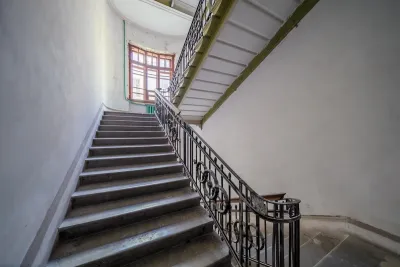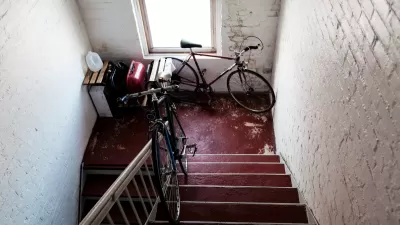Zoning codes have long prohibited single-stair residential buildings due to safety concerns, but changing that could lower the cost of construction and allow for more flexible housing designs.

Multifamily buildings with a single staircase don’t put residents at greater risk than double-staircase construction, according to a new study from Pew, contradicting a common belief that has led to restrictive zoning codes that outlaw single-stair buildings in most U.S. cities.
According to the Congress for New Urbanism’s Public Square, double stairwell requirements are “partly responsible for the dull, generic streetscapes” of most mid-rise neighborhoods because they “create large, long facades on a block that may suck the vibrancy out of streetscapes” and limit the amount of light that can enter the building.
Single-stairwell buildings can be built at a small-to-medium size in walkable neighborhoods. Single-stairwell buildings can fit onto small, irregularly shaped infill lots, contributing to missing middle housing.
In the past, “Cities required two stairwells for fire safety, but modern fire safety advancements and new building materials make the requirements superfluous.” Today, New York City, Seattle, and Honolulu are the only major U.S. cities to allow single-stair construction up to six stories, but the movement to legalize single-stair construction is growing, with bills to reform stair requirements proposed in jurisdictions including the Washington, D.C. region.
FULL STORY: Single stairs do not put residents at risk

Trump Administration Could Effectively End Housing Voucher Program
Federal officials are eyeing major cuts to the Section 8 program that helps millions of low-income households pay rent.

Planetizen Federal Action Tracker
A weekly monitor of how Trump’s orders and actions are impacting planners and planning in America.

Ken Jennings Launches Transit Web Series
The Jeopardy champ wants you to ride public transit.

Crime Continues to Drop on Philly, San Francisco Transit Systems
SEPTA and BART both saw significant declines in violent crime in the first quarter of 2025.

How South LA Green Spaces Power Community Health and Hope
Green spaces like South L.A. Wetlands Park are helping South Los Angeles residents promote healthy lifestyles, build community, and advocate for improvements that reflect local needs in historically underserved neighborhoods.

Sacramento Plans ‘Quick-Build’ Road Safety Projects
The city wants to accelerate small-scale safety improvements that use low-cost equipment to make an impact at dangerous intersections.
Urban Design for Planners 1: Software Tools
This six-course series explores essential urban design concepts using open source software and equips planners with the tools they need to participate fully in the urban design process.
Planning for Universal Design
Learn the tools for implementing Universal Design in planning regulations.
Heyer Gruel & Associates PA
Ada County Highway District
Institute for Housing and Urban Development Studies (IHS)
City of Grandview
Harvard GSD Executive Education
Toledo-Lucas County Plan Commissions
Salt Lake City
NYU Wagner Graduate School of Public Service





























